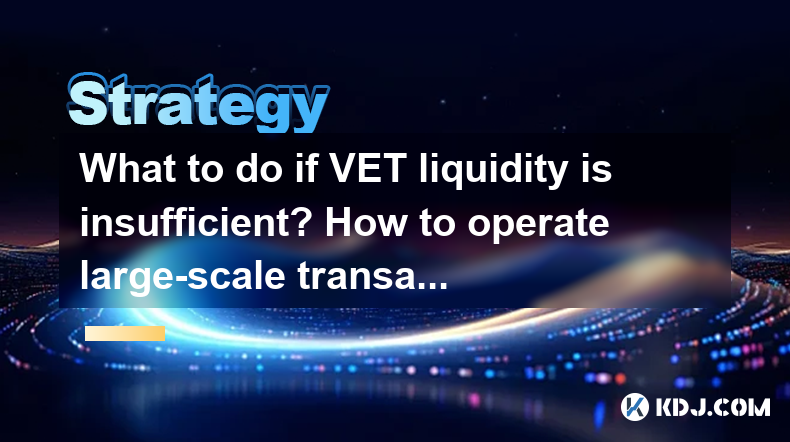-
 bitcoin
bitcoin $122025.899241 USD
-2.12% -
 ethereum
ethereum $4488.068729 USD
-4.11% -
 bnb
bnb $1315.348019 USD
8.65% -
 tether
tether $1.000457 USD
0.03% -
 xrp
xrp $2.875326 USD
-3.69% -
 solana
solana $222.043604 USD
-4.07% -
 usd-coin
usd-coin $0.999682 USD
0.00% -
 dogecoin
dogecoin $0.249887 USD
-5.62% -
 tron
tron $0.337379 USD
-2.59% -
 cardano
cardano $0.827763 USD
-5.06% -
 hyperliquid
hyperliquid $45.774531 USD
-2.43% -
 chainlink
chainlink $22.079309 USD
-5.87% -
 ethena-usde
ethena-usde $1.000156 USD
0.02% -
 sui
sui $3.482566 USD
-3.57% -
 stellar
stellar $0.386982 USD
-4.92%
What to do if VET liquidity is insufficient? How to operate large-scale transactions?
To manage large VET transactions with low liquidity, split orders, use DEXs, and employ trading bots and limit orders to minimize market impact and slippage.
May 07, 2025 at 06:35 am

When dealing with insufficient liquidity for VeChain (VET) and needing to execute large-scale transactions, understanding the intricacies of the market and the available tools is crucial. This article will explore strategies to handle low liquidity situations and provide detailed steps for managing large transactions in the VET ecosystem.
Understanding VET Liquidity
Liquidity in the context of cryptocurrencies like VeChain refers to the ease with which VET can be bought or sold in the market without significantly affecting its price. When liquidity is low, it can be challenging to execute large orders without causing price slippage, where the price moves against the trader's interest.
To assess VET's liquidity, you can look at several metrics:
- Trading Volume: High trading volumes generally indicate higher liquidity.
- Order Book Depth: A deeper order book means more buy and sell orders at various price levels, suggesting better liquidity.
- Bid-Ask Spread: A narrower spread typically indicates better liquidity.
Strategies for Dealing with Insufficient Liquidity
When VET liquidity is insufficient, several strategies can be employed to mitigate the risks associated with large transactions.
Splitting Large Orders
One effective method is to split large orders into smaller ones. This approach helps minimize the impact on the market price.
- Monitor the Market: Keep an eye on the current market conditions and order book to understand the best times to execute your trades.
- Use Limit Orders: Instead of market orders, use limit orders to control the price at which you buy or sell VET. This can prevent slippage.
- Execute Gradually: Place smaller orders over time to avoid sudden price movements. For instance, if you need to sell 1 million VET, consider breaking it into 10 orders of 100,000 VET each, spaced out over a period.
Utilizing Decentralized Exchanges (DEXs)
Decentralized exchanges can offer different liquidity pools that might not be available on centralized platforms.
- Research DEXs: Look for DEXs that support VET and have sufficient liquidity. Examples include Uniswap or SushiSwap, which might have VET liquidity pools.
- Use Liquidity Aggregators: Tools like 1inch or Matcha aggregate liquidity from multiple DEXs, helping you find the best prices and execute larger trades with less slippage.
- Participate in Liquidity Pools: If you're comfortable with the risks, adding your VET to a liquidity pool can earn you fees and improve overall liquidity.
Executing Large-Scale VET Transactions
When dealing with large-scale transactions, it's essential to have a well-thought-out plan to minimize the impact on the market.
Preparing for the Transaction
Before executing a large VET transaction, take the following steps:
- Analyze Market Trends: Use technical analysis tools to understand the current market sentiment and potential price movements.
- Set Clear Objectives: Determine the price at which you're willing to buy or sell and the total amount of VET you need to transact.
- Choose the Right Platform: Decide whether to use a centralized exchange (CEX) or a DEX based on liquidity and fees.
Executing the Transaction
Follow these steps to execute your large-scale VET transaction:
- Log into Your Exchange Account: Ensure you have a verified account on the chosen platform.
- Navigate to the Trading Section: Find the trading pair involving VET (e.g., VET/USDT).
- Place Orders: Use the following approach:
- For Selling: If selling 1 million VET, you might place 10 limit orders of 100,000 VET each, spread out over several hours or days.
- For Buying: Similarly, if buying 1 million VET, place 10 limit orders of 100,000 VET each, ensuring you don't chase the price up too quickly.
- Monitor and Adjust: Continuously monitor the market and adjust your orders as necessary to achieve the best possible outcome.
Using Advanced Trading Tools
Advanced trading tools can help manage large VET transactions more effectively.
Trading Bots
Trading bots can automate the process of placing and managing orders.
- Select a Bot: Choose a reputable trading bot like 3Commas or Cryptohopper that supports VET trading.
- Configure the Bot: Set up the bot to execute your strategy, such as splitting large orders into smaller ones and placing them at optimal times.
- Backtest and Monitor: Before deploying the bot on live markets, backtest your strategy to ensure it works as expected. Monitor the bot's performance and make adjustments as needed.
Stop-Loss and Take-Profit Orders
Using stop-loss and take-profit orders can help manage risk and secure profits.
- Set Stop-Loss Orders: Determine a price level at which you're willing to exit the trade to limit losses. For example, if you're selling VET at $0.05, you might set a stop-loss at $0.045.
- Set Take-Profit Orders: Decide on a target price to lock in profits. If you're buying VET at $0.05, you might set a take-profit at $0.06.
Managing Transaction Fees and Costs
Large transactions can incur significant fees, so it's important to manage these costs effectively.
Choosing the Right Exchange
Different exchanges have varying fee structures, so choose one that aligns with your transaction size.
- Compare Fees: Research and compare the fees of different exchanges. Some might offer lower fees for high-volume traders.
- Use Fee Discounts: Some exchanges offer fee discounts for using their native tokens or for holding a certain amount of their tokens.
Optimizing Transaction Timing
Timing your transactions can also help manage costs.
- Trade During High Liquidity Periods: Execute your trades during times when liquidity is typically higher, such as during major market hours.
- Avoid High Volatility Periods: High volatility can lead to higher slippage and fees, so consider avoiding these times if possible.
Frequently Asked Questions
Q: Can I use over-the-counter (OTC) trading for large VET transactions?A: Yes, OTC trading can be an option for large VET transactions. OTC desks can handle significant volumes without impacting the market price, but they often require a minimum transaction size and may have their own set of fees and requirements. Research reputable OTC desks that support VET trading and contact them to discuss your needs.
Q: Are there any specific tools or platforms recommended for tracking VET liquidity?A: Yes, several tools can help you track VET liquidity. CoinMarketCap and CoinGecko provide real-time data on trading volumes and liquidity across various exchanges. Additionally, platforms like TradingView offer advanced charting and liquidity analysis tools that can be useful for monitoring VET's market conditions.
Q: What should I do if my large VET transaction fails due to insufficient liquidity?A: If your transaction fails due to insufficient liquidity, consider the following steps:
- Reassess Your Strategy: Review your trading strategy and consider splitting your order into even smaller sizes or using a different exchange with better liquidity.
- Use a DEX or Liquidity Aggregator: Try executing your transaction on a DEX or through a liquidity aggregator to access different liquidity pools.
- Wait for Better Market Conditions: If possible, wait for a time when liquidity is higher, such as during peak trading hours or after significant market events that might increase trading volume.
Disclaimer:info@kdj.com
The information provided is not trading advice. kdj.com does not assume any responsibility for any investments made based on the information provided in this article. Cryptocurrencies are highly volatile and it is highly recommended that you invest with caution after thorough research!
If you believe that the content used on this website infringes your copyright, please contact us immediately (info@kdj.com) and we will delete it promptly.
- BlockDAG, DOGE, HYPE Sponsorship: Crypto Trends Shaping 2025
- 2025-10-01 00:25:13
- Deutsche Börse and Circle: A StableCoin Adoption Powerhouse in Europe
- 2025-10-01 00:25:13
- BlockDAG's Presale Buzz: Is It the Crypto to Watch in October 2025?
- 2025-10-01 00:30:13
- Bitcoin, Crypto, and IQ: When Genius Meets Digital Gold?
- 2025-10-01 00:30:13
- Stablecoins, American Innovation, and Wallet Tokens: The Next Frontier
- 2025-10-01 00:35:12
- NBU, Coins, and Crypto in Ukraine: A New Yorker's Take
- 2025-10-01 00:45:14
Related knowledge

Practical parameter settings for a Bitcoin multi-timeframe moving average system
Sep 18,2025 at 10:54pm
Optimizing Timeframe Combinations for Bitcoin Trading1. Selecting appropriate timeframes is crucial when building a multi-timeframe moving average sys...

How can I filter out false breakouts in Dogecoin high-frequency trading?
Sep 22,2025 at 01:00am
Understanding False Breakouts in Dogecoin Trading1. A false breakout occurs when Dogecoin's price appears to move beyond a defined support or resistan...

Techniques for identifying tops and bottoms in the Bitcoin on-chain NVT model
Sep 20,2025 at 07:54pm
Understanding the NVT Model in Bitcoin Analysis1. The Network Value to Transactions (NVT) ratio is often described as the 'P/E ratio' of the cryptocur...

What does the surge in open interest in Bitcoincoin futures mean?
Sep 20,2025 at 11:18pm
Understanding the Surge in Dogecoin Futures Open Interest1. A surge in open interest within Dogecoin futures indicates a growing number of active cont...

How can I use the Ethereum USDT premium to gauge market sentiment?
Sep 18,2025 at 11:55pm
Understanding the Ethereum USDT Premium1. The Ethereum USDT premium refers to the price difference between USDT (Tether) traded on Ethereum-based plat...

What should I do if Ethereum staking yields decline?
Sep 20,2025 at 06:18am
Understanding the Causes Behind Declining Ethereum Staking Yields1. The Ethereum network transitioned to a proof-of-stake consensus mechanism with the...

Practical parameter settings for a Bitcoin multi-timeframe moving average system
Sep 18,2025 at 10:54pm
Optimizing Timeframe Combinations for Bitcoin Trading1. Selecting appropriate timeframes is crucial when building a multi-timeframe moving average sys...

How can I filter out false breakouts in Dogecoin high-frequency trading?
Sep 22,2025 at 01:00am
Understanding False Breakouts in Dogecoin Trading1. A false breakout occurs when Dogecoin's price appears to move beyond a defined support or resistan...

Techniques for identifying tops and bottoms in the Bitcoin on-chain NVT model
Sep 20,2025 at 07:54pm
Understanding the NVT Model in Bitcoin Analysis1. The Network Value to Transactions (NVT) ratio is often described as the 'P/E ratio' of the cryptocur...

What does the surge in open interest in Bitcoincoin futures mean?
Sep 20,2025 at 11:18pm
Understanding the Surge in Dogecoin Futures Open Interest1. A surge in open interest within Dogecoin futures indicates a growing number of active cont...

How can I use the Ethereum USDT premium to gauge market sentiment?
Sep 18,2025 at 11:55pm
Understanding the Ethereum USDT Premium1. The Ethereum USDT premium refers to the price difference between USDT (Tether) traded on Ethereum-based plat...

What should I do if Ethereum staking yields decline?
Sep 20,2025 at 06:18am
Understanding the Causes Behind Declining Ethereum Staking Yields1. The Ethereum network transitioned to a proof-of-stake consensus mechanism with the...
See all articles










































































